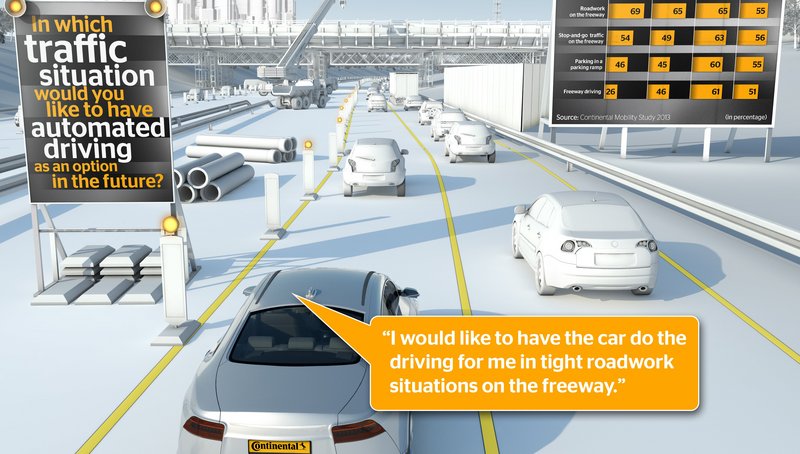Motorists Worldwide Open to Automated Driving
- Rising traffic density increasing stressful for motorists – one in two have already had an accident while at the wheel
- Advanced driver assistance systems already enjoy great popularity worldwide
- Positive experience with driver assistance systems paves the way to acceptance of automated driving
- Automation considered useful in freeway situations in particular
- Guarded expectations worldwide for market availability but price estimates realistic
- Asian drivers in particular want to put their time behind the wheel to alternative use
Hanover, January 14, 2014. Motorists worldwide are principally open to automated driving. A clear majority of participants in the "Continental Mobility Study 2013" welcome technology of this kind: 79% in China, 61% in Japan, 53% in Germany, and 41% in the U.S. realize the benefit of automated driving. When asked about their individual intentions for using the technology, drivers specified they would chiefly like to be driven through freeway roadwork and traffic jams as well as along long freeway stretches. They would also like to have their cars park themselves in parking garages.
These preferences tie in perfectly with the information given by those surveyed regarding their everyday experiences in traffic: The results of the study reveal that increased traffic density (Japan 64%, Germany 51%, the U.S. 49%, and China 27%), traffic jams, and stop-and-go driving (Japan 68%, Germany 63%, the U.S. 52%, and China 22%) are the primary factors associated with heightened stress worldwide. With the exception of motorists in China (48%), most motorists do, nonetheless, still like to have their hands on the wheel (Germany 67%, the U.S. 63%, and Japan 57%) and trust their own driving skills (the U.S. 85%, Germany 63%, China 60%, and Japan 53%). Only a minority are completely averse to driving (Japan 17%, China 11%, Germany 9%, and the U.S. 5%).
"The needs of motorists worldwide are a perfect match for the development possibilities in the upcoming years. This is because partially automated vehicles will begin by gaining the ability to navigate through roadwork and traffic jams on the freeway; next in line will be the ability to park on their own in parking garages," said Dr. Elmar Degenhart, chairman of the Continental Executive Board. He was speaking in Hanover on Thursday on the occasion of the publication of the study. "What's more, the results illustrate that the successful introduction of advanced driver assistance systems worldwide in conjunction with the direct customer benefits derived from them has paved the way to the acceptance of automated driving," he added.
For the "Continental Mobility Study 2013", the international automotive supplier Continental had the market and social research institute infas conduct a representative survey of motorists in Germany, the U.S., Japan, and China, and a qualitative survey in France, India, and Brazil. Furthermore, experts from the science domain (traffic psychology, law) and the automotive industry were also interviewed. This makes it one of the world's most comprehensive studies of its kind looking into the acceptance of advanced driver assistance systems and automated driving.
One motorists in two has already had an accident while at the wheel
The study results are quite shocking when it comes to accidents. In the countries covered by the study, one motorist in two admits to already having been involved in an accident while at the wheel (Germany 59%, China 57%, Japan 48%, the U.S. 62%), with rear-end collisions the most common cause of accidents. 46% of participants in the U.S., 45% in China, 44% in Germany, and 37% in Japan have already experienced this type of accident while driving. "Emergency brake assist systems are already available for all vehicle classes. They can prevent many cases of rear-end collisions. Initial insurer rebates for vehicles equipped with emergency brake assist systems and consumer tests – such as Euro NCAP – have lent enormous momentum to the driver assistance system market. These systems can thus be expected to make ever deeper inroads into all vehicle classes in the future," noted Frank Jourdan, member of the Continental Executive Board and head of the Chassis & Safety division, commenting on the results.
Advanced driver assistance systems enjoy tremendous international popularity
The increasing industrialization of advanced driver assistance systems since the turn of the century has, in the meantime, reduced the cost of the requisite technology – environmental sensors such as cameras, radars, and lidars – to such an extent that these systems can now be offered in all vehicle classes. The results of the "Continental Mobility Study 2013" clearly demonstrate this democratization effect: Convenience-oriented advanced driver assistance systems already enjoy high usage rates. In international comparison, cruise control (the U.S. 67%, Germany 51%, China 50%, and Japan 20%), parking sensors (China 55%, Germany 50%, the U.S. 19%, and Japan 18%), and rear-view cameras (China 71%, Japan 34%, the U.S. 20%, and Germany 13%) are the frontrunners.#
On the whole, convenience-oriented advanced driver assistance systems enjoy tremendous popularity: 90% of motorists in Germany and China, 84% in the U.S., and 82% in Japan appreciate the usefulness of these systems.
Safety-oriented advanced driver assistance systems are very well well known among motorists, yet their range of application is still limited. Emergency brake assist is the best-known feature in all countries covered by the study (85% in Japan, 61% in Germany, 54% in the U.S., and 38% in China). However, with the exception of electronic stability control (ESC) (62% in Germany, 32% in China, 19% in Japan, and 16% in the U.S.), the figures show that Chinese motorists in particular lead the way internationally in usage rates for these features. Being relatively young (74% less than five years old), the Chinese vehicle population makes high use of features like lane change assist (41%), lane departure warning (36%), and parking assist (30%). On the whole, acceptance levels for safety-oriented advanced driver assistance systems paint an all-round positive picture. 93% of motorists in Germany and China, 84% in Japan, and 78% in the U.S. regard these systems as useful.
And a glance at how acceptance levels correlate with driver characteristics such as age, miles driven, and driver type reveals that such factors do not play a significant role in the distribution of acceptance among motorists in the countries covered by the study. "There is no such thing as the typical user of advanced driver assistance systems, neither in Germany and the U.S. nor in Japan, or China. The acceptance of advanced driver assistance systems is thus not a question of age, miles driven, driver type, or vehicle class," explained Jourdan.
Automated driving generally useful, but similar concerns persist worldwide
The majority of motorists surveyed in Germany (67%), China (64%), and the U.S. (50%) are familiar with automated driving. However, in Japan, slightly less than one out of every three motorists (29%) has ever even heard of automated driving. After receiving an explanation of precisely how it works, more than half of all drivers (China 79%, Japan 61%, Germany 53%, and the U.S. 41%) viewed the option of having the vehicle take over the driving as a useful future development. At the same time, the results of the study show that automated driving is not yet as familiar to people as advanced driver assistance systems. A large number of the motorists surveyed in the study worldwide are not convinced that automated driving will function reliably (74% in China, 50% in the U.S., 48% in Germany, 43% in Japan).
What's more, automated driving is an unsettling possibility for more than half of these motorists (52% in China and Germany, and 42% in Japan). At 66%, worries are particularly marked in the U.S. The results of the study do, however, also reveal the following: the greater the acceptance of advanced driver assistance systems, the greater the acceptance of automated driving. "Experience with advanced driver assistance systems has a positive effect on the way people view automated driving. People who have themselves had a chance to experience how reliably emergency brake assist functions in in their own cars don't question the basic feasibility of automated driving," explained Christian Senger, head of automotive electronics advanced development at Continental.
The distribution of acceptance levels for the two further correlates in that automated driving, like advanced driver assistance systems, does not appeal merely to a certain special type of motorist.
The majority (62%–76%) of motorists surveyed can see the benefit of automated driving in long trips on the freeway. However, perspectives vary regarding the use of these technologies in traffic jams on the freeway. 70% of German motorists view it as useful, whereas only 36% of U.S. drivers do, with the figures 59% and 43% in Japan and in China respectively. Automated driving on freeways does, however, receive the most support overall.
While guarded as to market availability, motorists are realistic as to price
The availability of partially automated vehicles – which still require constant traffic monitoring – varies from country to country. Half of all motorists in China expect vehicles with partially automated features to be available between 2018 and 2019. Next in line is Germany (with availability expected in 2023), followed by the U.S. (2024), and Japan (between 2024 and 2028). Overall, more than half of all motorists surveyed worldwide estimate that automated driving will be part of everyday life in 10 15 years. Motorists in China have the most optimistic outlook (65%) in this regard, ahead of Japan (57%), the U.S. (53%), and Germany (50%).
As part of the study, those surveyed were also able to express their expectations regarding the price of individual features. Generally speaking, price estimates were lower among those surveyed in the U.S. than among those surveyed in Japan, China, and Germany.
German motorists, for example, estimated an average price of €2,900 for automated freeway driving, followed by China with €2,600, Japan with €2,300, and the U.S. with €1,100. This works out to 14% of the average purchase price of a new car in both China and Japan, 10% of one in Germany, and 5% in the U.S.(Source: POLK 2013).
"On the whole, motorists worldwide have a realistic idea of price. What's more, they will be able to use partially automated driving features earlier than they expect," said Senger, commenting on the expectations for the price and availability of partially automated driving features.
Click here for more information and more pictures:


